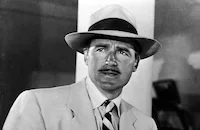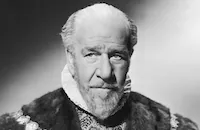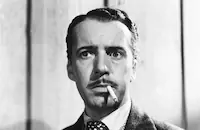Ivy

Brief Synopsis
Cast & Crew
Sam Wood
Joan Fontaine
Patric Knowles
Herbert Marshall
Richard Ney
Sir Cedric Hardwicke
Film Details
Technical Specs

Synopsis
In England at the turn of the century, Ivy Lexton, a self-centered, seductive young woman, consults a fortune-teller, who portends that Ivy will come into an abundance of money as soon as she rids herself of one man and another enters her life. Unspoken by the fortune-teller is the grisly misfortune that will also befall Ivy. Ivy believes that the prediction is coming true when she meets Miles Rushworth, an enormously wealthy bachelor, and convinces him to give her husband Jervis a position in his firm. In the five years that Ivy and Jervis have been married, Ivy has squandered Jervis' wealth, forcing them to live in the modest circumstances so despised by Ivy. Later, at a lavish dance, Ivy is approached by Dr. Roger Gretorex, her secret lover. When Ivy tries to fulfill the prophesy by breaking off her affair with Roger, Roger vows to never give her up. The next morning, Miles invites Ivy and Jervis on a month-long cruise aboard his yacht. Ivy is relieved when Bella Crail, Miles's alleged fiancée, leaves the boat mid-voyage, thus allowing Ivy to work her charms on the unsuspecting millionaire Entranced by Ivy, Miles follows her ashore one day and buys her an extravagant handbag with the cameo clasp that she admires. Later, during a storm, Miles invites Ivy to his cabin for dinner. When lightning knocks out the electricity, Miles arduously embraces Ivy and then apologizes for his indiscretion and leaves. Upon returning home, the Lextons settle into their luxurious new quarters and Jervis begins his new job. After Miles leaves on a business trip to South Africa, Roger phones Ivy, who tries to avoid him until he demands an audience with her in one hour. Before leaving for Roger's house, Ivy argues with Jervis about her extravagance. Feigning tearful remorse, Ivy suggests a divorce, but Jervis refuses her offer. Ivy then goes to see Roger at his office. When Roger is called away to tend a patient, Ivy spots a bottle of poison on the table. Realizing that Jervis will never free her, Ivy pours a spoonful of the powder into her purse. At home, Ivy gradually administers the poison to Jervis by slipping it in his brandy. When Ivy continues to ignore Roger's constant calls, he goes to the Lexton house and discovers that Ivy has gone out for the evening and Jervis is sick in bed. As Roger listens to Jervis' symptoms and offers him a glass of water, Jervis' physician, Dr. Lancaster, arrives and objects to Roger's interference in his case. Upon returning home late that night, Ivy is informed by Dr. Berwick, Lancaster's colleague, that Jervis is dead. To determine the cause of death, Berwick orders a postmortem. Early the next morning, Berwick arrives with Inspector Orpington of Scotland Yard to conduct an investigation into Jervis' death. When Emily Green, the Lextons' maid, mentions that Roger visited Jervis on the evening of his death, Berwick concludes that Roger may be responsible for Jervis' demise. Informed by Orpington that her husband was poisoned, Ivy feigns aggrieved widowhood and casts suspicion of Roger by implying that he was jealous of Jervis. Once Orpington departs, Ivy dumps the poison from her purse and then hurries to Roger's office to beg him to protect her by lying that she has never visited his house. Led to believe by Ivy that Jervis took his own life, Roger extracts a promise from his housekeeper, Martha Huntley, never to reveal that Ivy has visited him. Soon after, Orpington arrives and to shield Ivy, Roger lies about his relationship with her. Later, Roger is arrested on suspicion of murder. On the day of the arrest, Miles cables Ivy his condolences and promises to hurry to her side. After Roger refuses to defend himself, Ivy takes the witness stand and testifies that Roger was in love with her and wanted to marry her. To protect Ivy from further humiliation, Roger pleads guilty and is sentenced to hang. Suspicious of Ivy's eagerness to implicate Roger in the murder, Orpington decides to continue his investigation. On the eve of Roger's execution, his mother, Mrs. Gretorex, visits Ivy, and finding her preparing to leave for the country, chastises her for failing to defend Roger. Mrs. Gretorex then repairs to Roger's house and soon after, Orpington appears and declares that he believes that Roger is shielding Ivy, the true killer. After Orpington tricks Martha into revealing that Ivy had access to the poison at Roger's office, she recalls that Ivy was carrying her cameo purse that day. Proceeding to Ivy's flat to search for the purse, Orpington finds a cable from Miles, notifying her that he will be arriving by ship the next day. After locating the handbag in the back of a grandfather clock, Orpington discovers poison residue embedded in a secret pocket and then goes to meet Miles at the docks. Later that night, Roger's lawyer phones Ivy to inform her that Roger has been released because of new evidence. Bolting home to London, Ivy finds Miles waiting for her at the apartment. Miles, who has been apprised of Ivy's heinous deeds, confirms her guilt and then walks out on her. Agitated, Ivy flees into the hallway, and wrongly believing that the elevator is waiting for her, plunges down the empty shaft to her death.

Director

Sam Wood
Cast

Joan Fontaine

Patric Knowles

Herbert Marshall
Richard Ney

Sir Cedric Hardwicke

Lucile Watson
Sara Allgood

Henry Stephenson

Rosalind Ivan
Lilian Fontaine

Molly Lamont

Una O'connor

Isobel Elsom

Alan Napier

Paul Cavanagh
Charles Mendl
Gavin Muir
Mary Forbes
Norma Varden
Lumsden Hare
Matthew Boulton
Lydia Bilbrook
Alan Edmiston
Harry Hays Morgan

Holmes Herbert
C. Montague Shaw
Claire Du Brey
Gerald Hamer
Colin Campbell
Alan Admiston
David Cavendish
Renee Evans
Judith Woodbury
Jean Fenwick
David Ralston
Ella Ethridge

Boyd Irwin
Wally Scott
Dave Thursby
Art Foster
Leon Lenoir
Jack Boyjan
Albert Morin
Lois Austin
Herbert Clifton
James Logan
Eric Wilton
Frank Tomlinson
Charles Knight
Schuyler Mcguffin
Harry Evans
Norman Ainsley
Al Ferguson
Dave Dunbar
Herbert Evans
Manuel Paris
Wyndham Standing
Clive Morgan
J. C. Johnston
John Peters
Nigel Horton
Robert Hale
Elsa Peterson
James Fairfax
Robert Cory

Bess Flowers
Crew
Daniele Amfitheatrof
Charles Bennett
Ralph Dawson
Carmen Dirigo
Charles Felstead
Russell A. Gausman
William Hedgcock
David [s.] Horsley
Paul Mantz
William Cameron Menzies
Russell Metty
T. F. Offenbecker
Orry-kelly
Richard H. Riedel
John F. Sherwood
David Tamkin

Film Details
Technical Specs

Articles
Ivy
Although Richard H. Riedel is the nominal art director for Ivy, it is generally considered that Menzies' guiding hand is responsible for the movie's striking visuals, which also include the cinematography of Russell Metty and costume designs by Orry-Kelly and an uncredited Travis Banton. Wood and Menzies had worked together on some half-dozen other films including, notably, 1942's Kings Row, 1943's For Whom the Bell Tolls - and Gone With the Wind itself, for which Wood directed some scenes.
Frequent Hitchcock collaborator Charles Bennett (1935's The 39 Steps and 1940's Foreign Correspondent) wrote the screenplay for Ivy, in which the title character, played by Joan Fontaine, is a beautiful and seemingly sweet yet ruthless woman who cares only for riches and the lovely things they can bring her. Already involved in a loveless marriage and a fading love affair, Ivy sets her sights on the congenial and super-rich Miles Rushworth (Herbert Marshall). When he refuses to become involved with a married woman, she plots to slowly poison her husband (Richard Ney) and frame her lover (Patric Knowles) for the murder, freeing herself of both bothersome men in her life and moving on to richer pastures.
The setup allows Menzies and his associates to offer their dazzling designs in service to the story, in which Ivy constantly lusts for opulence. As John DiLeo writes in his book Screen Savers II: My Grab Bag of Classic Movies, "Every awful thing Ivy does is in the name of beauty: glittering gowns, enormous hats, jeweled handbags. Her accoutrements are the content of the film; they drive Ivy to commit reprehensible acts." Fellow production designer Richard Sylbert described Ivy, because of its reliance on art direction, as "the perfect Menzies movie."
The capable supporting cast is headed by Sir Cedric Hardwicke as the Scotland Yard inspector investigating the case, Una O'Connor as a fortune-teller who sees Ivy's future all too clearly, and Lucile Watson as Knowles's mother. Lillian Fontaine, the star's mother, appears to little effect as Lady Flora, whose daughter is engaged to the Marshall character. Hoagy Carmichael wrote the film's title song and sings it on the soundtrack.
Originally set for the leading role was Fontaine's competitive sister, Olivia de Havilland. She was only four days from costume tests with her old friend from her home studio of Warner Bros., Orry-Kelly, when she announced that she was dropping out of Ivy. She had misgivings about the role from the start, fearing that the character was so unsympathetic that audiences would not identify and the film would be a commercial disappointment. De Havilland had recently played a pair of twins in The Dark Mirror (1946), one good and one bad, and hated playing the evil sister. The crowning blow came when de Havilland learned that her agents, Berg-Allenberg, secretly had financial interests in the production company that would make the film and wanted her cast for that reason. It was a costly decision for her to exit the movie because she had already turned down other roles and was out of work for six months, losing income of some $100,000.
The sisters were at the height of their famous feud, and many in Hollywood felt it was an act of retaliation when agent Phil Berg offered the role to Fontaine. She was only too happy to step into de Havilland's elaborate Orry-Kelly wardrobe and to be cast against type as a scheming femme fatale. (Travis Banton completed the costume scheme after Fontaine entered the picture.) Many of Ivy's lacy gowns are a virginal white, offering ironic contrast to her decadent ways, and Fontaine's generous displays of creamy cleavage are slightly shocking for a film of this period.
Heretofore, Fontaine's best-known roles had been those of shy, retiring heroines in such movies as Rebecca (1940) and Suspicion (1941). The former had brought her a Best Actress Academy Award nomination and the latter the Oscar itself. Ivy not only shattered the typecasting mold for Fontaine, leading to more complex and not always sympathetic roles, but established her as one of the movies' true beauties. Metty photographs her as lovingly as any of the film's other gorgeous artifacts, and the result is stunning.
Like de Havilland, who had worked with Sam Wood on Gone With the Wind and Raffles (1939), Fontaine did not enjoy working with her director. She felt that Wood considered her merely one part of the film's design, a lovely and exquisitely dressed mannequin but not a commanding dramatic figure. She did, however, appreciate Menzies' work and reportedly was "fascinated" by the expressionistic paintings he created to illustrate each of the movie's major setups.
Ivy received mixed reviews; Variety's reviewer praised the look of the film but complained of "directorial obviousness." The star received her share of praise, with The New York Times critic noting that "Miss Fontaine has sunk her teeth into a role that is nothing short of a tour de force." However, de Havilland was correct in predicting that, because of the unsympathetic nature of its heroine, the movie would perform poorly at the box office.
Fontaine recreated her role in three radio adaptations of Ivy: two for "The Screen Guild Theater," on January 19, 1948, and March 13, 1952; and another for "Screen Director's Playhouse" on January 11, 1951. Martha Hyer starred in an adaptation on Lux Video Theatre on January 19, 1956.
by Roger Fristoe

Ivy
Quotes
Trivia
Notes
The working title of this film was The Story of Ivy. The picture was the first release of Sam Woods's production company, Inter-Wood Productions. According to an August 1946 Hollywood Reporter news item, the Shrine Auditorium in Los Angeles was converted to look like the Salzburg Music Festival for the production. July 1946 Hollywood Reporter news items announced that Olivia De Havilland, Joan Fontaine's sister, was set in the title role; De Havilland withdrew from the project in November 1946, however. According to a September 1947 news item in Los Angeles Examiner, De Havilland later sued her agent for concealing the fact that he owned an interest in the film while trying to induce her to accept the role. The outcome of that suit has not been determined. A May 1947 Hollywood Reporter news item states that Edmond O'Brien was originally assigned to play the "other man." A January 1947 Hollywood Reporter news item adds that Hoagy Carmichael was to write a song titled "Ivy" that would not be performed in the film but would be used thematically throughout the musical underscoring. Lillian Fontaine, who played "Lady Flora," was Fontaine's mother. According to production notes contained in the AMPAS Library, the period of the film was set back twenty years from the original setting of Marie Belloc Lowndes's novel. A modern source adds that producer William Cameron Menzies was responsible for the production design of the film. On January 19, 1956, Lux Video Theater broadcast an adaptation of the film scenario starring Martha Hyer.














